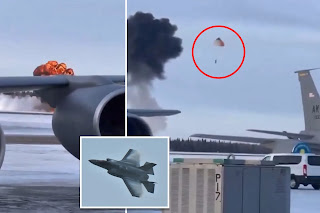F-35 Fighter Jet Crashes at Eielson Air Force Base: Investigation Underway
An F-35 fighter jet has crashed at Eielson Air Force Base in Alaska, raising concerns about the aircraft’s safety and operational reliability. The incident, which occurred during a routine training mission, has prompted an immediate investigation by military officials. The crash adds to a series of issues faced by the F-35 program, one of the most advanced and expensive fighter jet projects in history.
The Crash: What Happened?
The F-35, a fifth-generation stealth fighter, was conducting a standard training flight when the pilot encountered an issue that led to the crash. Witnesses reported seeing the jet descending rapidly before impact. Fortunately, the pilot managed to eject safely and was recovered by emergency response teams. The extent of their injuries, if any, has not been disclosed.
The crash site was quickly secured by military personnel, and local authorities were notified to prevent unauthorized access. The incident has raised immediate questions about what caused the crash and whether it was due to mechanical failure, human error, or environmental factors.
Emergency Response and Investigation
Following the crash, emergency teams at Eielson Air Force Base responded swiftly, ensuring that the pilot received medical attention and that any potential hazards, such as fuel leaks or fire, were contained. The Air Force has launched a full-scale investigation, working alongside Lockheed Martin, the manufacturer of the F-35, to determine the cause of the accident.
Military aviation experts will analyze flight data, inspect wreckage, and review maintenance records to piece together what went wrong. The investigation will be crucial in understanding whether this crash is an isolated event or part of a larger trend affecting F-35 operations.
Potential Causes: Mechanical Failure or Pilot Error?
The F-35 program has faced criticism over the years for technical issues, including software malfunctions, maintenance challenges, and mechanical failures. Some previous crashes have been attributed to engine problems, oxygen system failures, and avionics glitches. However, pilot error is always a possibility in aviation accidents, especially during high-speed, complex maneuvers.
Given the aircraft’s advanced technology, any malfunction in the flight control system, navigation software, or power supply could have contributed to the crash. Investigators will examine whether a technical defect played a role or if external factors, such as extreme weather conditions in Alaska, were involved.
Impact on the F-35 Program and Military Readiness
The F-35 program, despite being one of the most sophisticated fighter jet initiatives, has not been without controversy. With a price tag exceeding $1.7 trillion over its lifetime, the aircraft has been scrutinized for cost overruns, delays, and technical setbacks.
This crash at Eielson Air Force Base could lead to further questions about the jet’s reliability and whether additional safety measures need to be implemented. If systemic issues are found, it may prompt temporary groundings of F-35s across the Air Force until a solution is identified. Such a move could impact military readiness, as the F-35 is a key component of U.S. air superiority strategy.Pilot Safety and Ejection System Performance
One positive outcome of this incident is that the pilot successfully ejected and survived. The F-35’s ejection system has been improved over the years, following concerns about its effectiveness, particularly for lighter pilots. The survival of the pilot in this crash suggests that the ejection system performed as intended, preventing what could have been a fatal outcome.
The Air Force will likely review this event to determine if any modifications are needed to enhance pilot safety further. Ensuring that ejection procedures and parachute deployment work effectively is crucial for preventing casualties in future emergencies.
Public and Military Reactions
The crash has drawn attention from both military experts and the public. While aviation accidents are not uncommon, crashes involving expensive and high-tech aircraft like the F-35 raise concerns about cost-effectiveness and reliability.
Military officials have assured the public that all necessary steps are being taken to investigate the incident thoroughly. They emphasize that safety remains a top priority and that lessons learned from this crash will help prevent future accidents.
At the same time, defense analysts will be closely watching how this incident affects ongoing debates about the F-35’s future. Some critics argue that alternative aircraft should be considered, while supporters maintain that the F-35 remains the most capable fighter in the world despite its challenges.
Conclusion: A Critical Moment for the F-35 Program
The crash of an F-35 at Eielson Air Force Base highlights the risks inherent in military aviation. While the pilot’s survival is a testament to the effectiveness of modern safety systems, the incident underscores the need for continued scrutiny of the aircraft’s performance and reliability.As the investigation unfolds, the Air Force and Lockheed Martin will work to determine the cause and implement any necessary changes. Whether this crash is a one-time event or a sign of deeper issues within the F-35 program remains to be seen. For now, the focus will be on ensuring that future flights are as safe as possible and that America’s most advanced fighter jet lives up to its reputation.



Comments
Post a Comment